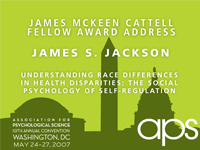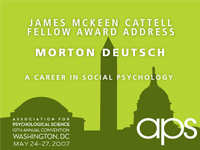Decisions, Decisions
The themed program “Risky Decision-Making Across the Lifespan” at the APS 19th Annual Convention included a symposium on everything from the neurological basis for decision-making to the wide-reaching societal implications of understanding how we make the myriad decisions we face everyday.
Sage or Just Age?
According to Ellen Peters, Decision Research and the University of Oregon, by 2050 the number of people over 60 will surpass people under 15 for the first time in history, underscoring the importance of research into how older adults make decisions. Peters’ research shows that although the cognitive decline associated with age makes it seem that older people would make worse decisions, they actually have a lifetime of experience to draw from and that older people can bring their “deliberative capacity to bear when it matters.” She also reported that older individuals tend to focus on positive information when making decisions. More research is needed to determine if this positivity effect is the result of a bias toward positive information or the result of ignoring negative information.
Andrew Williams, along with his colleague Melissa Finucane at the Kaiser Permanente Center for Health Research, is developing a new measure of decision-making competence in older adults. Their method uses the Multiple Cue Probability Learning paradigm, reflecting the dynamic and uncertain decision environment better than current methods that rely on self-report, interviews, and clinical and family judgments. Their approach permits quantification of several of the major components of decision-making: comprehension (e.g. reading charts correctly); insight (e.g. understanding how information is relevant, and the limitations of one’s knowledge); and consistent information integration (e.g. realizing that certain features will be constant across similar situations). Researchers using this approach asked participants to judge the likelihood that someone has diabetes on the basis of three symptom cues represented by graph bar heights over a series of trials. The results have been encouraging and, with more work, may lead to the development of new tools for understanding the ways that adult decision-making changes with age and what kind of decision supports would be of most benefit to older adults.
Wandi Bruine de Bruin, Carnegie Mellon University, also is working to develop a measure of decision-making competence with the goal of capturing multiple factors of good decision-making, including resistance to framing of the presented information, ignoring sunk costs, and accurate confidence in a decision. In a study testing her measure, recently published in the Journal of Personality and Social Psychology, the results were compared to the results of participants’ Decision Outcome Inventory, which asks about real-life occurrences that would have, at least in part, resulted from poor decision-making, such as going to jail, acquiring Type 2 diabetes, or bouncing checks. Scoring well on the new measure of Decision-Making Competence developed by Bruine de Bruin and her colleagues correlated with fewer poor real-life decisions, even after controlling for existing measures of cognitive ability and socioeconomic status, indicating that Bruine de Bruin is on the right track to developing a valid measure.
Wasted Youth?
We know that adolescents are different from you and me, but does that difference extend to how they make decisions? Is their process neurologically different than that of adults? To find out, Abigail Baird, Vassar College, went straight to the source: teenagers. As adults, there are some decisions we don’t have to think about. Eating a salad? Good idea. Swimming with sharks? Bad idea. This is because our amygdala and insula, the parts of the brain that initiate our fight/flight response, give us an instinctual sense that something is good or bad. However, it’s not always that simple. When asked questions similar to those above, teenagers and adults all came to the same good/bad conclusions, but the teenagers took significantly more time to do so when the decisions involved potentially risky situations. Whereas the adults showed quick reactions of the amygdala and insula, the teenagers also involved their frontal cortex, the center of reasoning and logic. Essentially, this means that teenagers have not yet developed the gut instinct or reflex and were thinking about the questions more.
On the surface, carefully thinking over a decision is a good thing and very necessary for more complex decisions. But initial fight/flight responses to obvious decisions are necessary, too, and thinking too much can leave the brain open to being “blindsided” by emotion, most often by means of peer interactions. When teenagers are mulling over a question of right or wrong, safety or danger, they take into account what others do or think, something Baird, a Past Secretary of APS, calls “the Haley effect.” (As in, “I’m pretty sure swimming with sharks is a bad thing, but I want to know what my best friend Haley thinks before I totally make up my mind.”) This, combined with a shifting focus from parents to peers in the teenage years, as well as a new awareness of the imaginary audience (the “they” who will be so merciless if a kid doesn’t have the latest shoes or the “everyone” who will be at that party), makes peer pressure a powerful force in risky decision-making for adolescents.
Daniel Romer, University of Pennsylvania, presented a different rationale for adolescents’ seeming cluelessness when it comes to decision-making. Romer explained that adolescence is a relatively recent cultural phenomenon, which has been elongated since the 1900s with the progress of the industrial revolution and universal education. Earlier generations of adolescents were expected to assume adult responsibilities at an earlier age and received adult guidance in the process. Also, studies have shown that the amount of dopamine released and the number of dopamine synapses increase during adolescence. This increase in dopamine has been correlated with an increase in sensation-seeking behavior — which in our media saturated culture often leads to your good old sex, drugs, and rock-and-roll. So adolescents are left in a non-adult, “responsibility-lite” situation at just the time when they want to engage in novel and exciting behavior the most.
How can we help teenagers avoid these risks? Psychology-based public policy has come up with some answers. The U.S. Department of Education is running pilot school programs teaching problem-solving skills, starting early in elementary school. One of the most successful risk-reduction policies has been graduated driver’s license programs. In these programs, states restrict beginners’ licenses in a variety of ways (e.g., not allowing other teenagers in the car or not allowing teens to drive at certain times of night). States that have incorporated at least five of these types of measures have seen a 30 percent decline in fatal teenage accidents.
Intersecting with Public Policy
APS Fellow Baruch Fischhoff, Carnegie Mellon University, also laid out the impact that decision-making research can have on public policy. As Fischhoff says, psychologists are beginning to learn “the language of policy,” realizing that their research can and should have an impact on risk-related policy. Psychology is everywhere in policy decisions: in the judgments and perspectives involved in developing and implementing a policy, in the behavior of those who are the targets of a policy, and in the decision-making approaches of those who assess the impact of a policy. It follows that policy making will be more effective if based on psychological science’s knowledge of how people “assess risks (and benefits), understand and follow instructions, consult and control their emotions, create and use social support, and evaluate authorities’ trustworthiness.”
In one example of the intersection of psychology and public policy, Fischhoff and Donna Riley were approached by a group of industry and government bodies to evaluate how best to label the solvent methylene chloride. Methylene chloride had just been declared a probable carcinogen, posing lifetime risks in addition to the acute risks posed by its giving off carbon monoxide. Despite these risks, nothing beats it when it comes to stripping paint and a label needed to be devised that would allow someone to repaint their living room without causing life-long damage (awful paint color choices notwithstanding). Fischhoff and his team created a model of how the compound diffuses in the air in order to determine the safest ways to use it. They then tested various labels in terms of how well they conveyed the information that consumers needed — finding most wanting. Using this new understanding, Fischhoff and the other researchers were able to recommend an appropriate new label for this dangerous chemical. As Fischhoff says, by understanding decision-making at all ages and becoming part of processes like these, psychologists can “[increase] the envelope of autonomous decisions.”





APS regularly opens certain online articles for discussion on our website. Effective February 2021, you must be a logged-in APS member to post comments. By posting a comment, you agree to our Community Guidelines and the display of your profile information, including your name and affiliation. Any opinions, findings, conclusions, or recommendations present in article comments are those of the writers and do not necessarily reflect the views of APS or the article’s author. For more information, please see our Community Guidelines.
Please login with your APS account to comment.